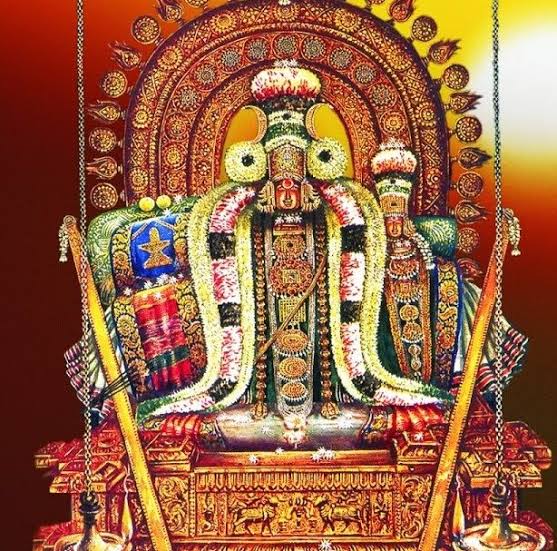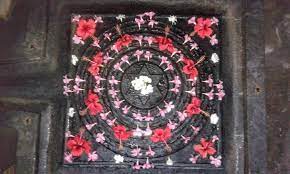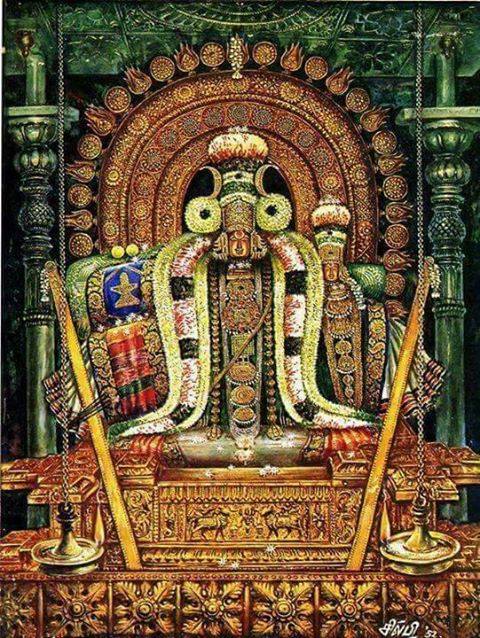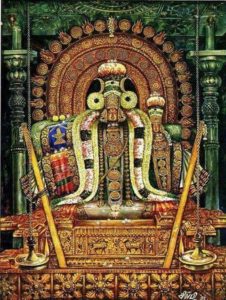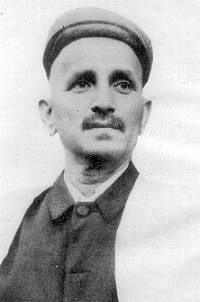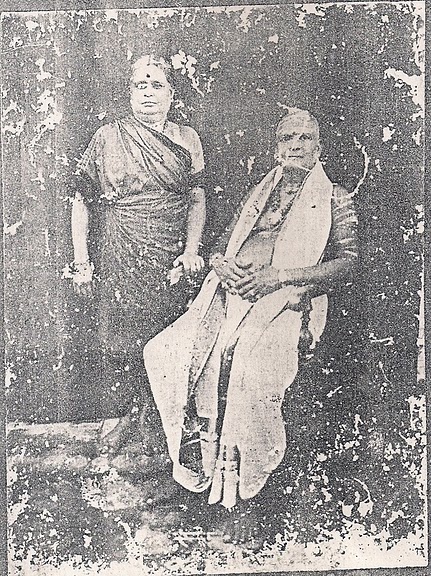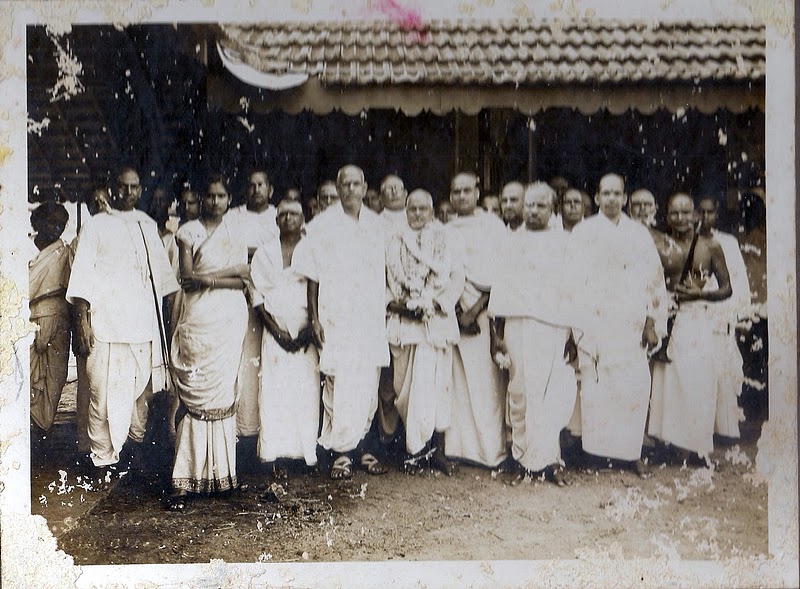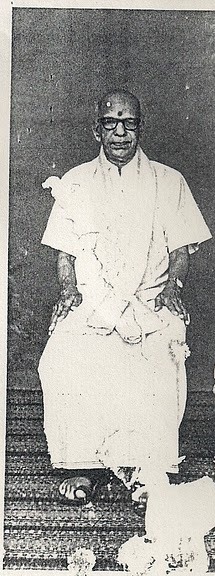நாம் இன்று மிகவும் ப்ரஸித்தமான பரிசிதமான கீர்த்தனங்களை மட்டும் அறிவோம். இவற்றுக்கு முன்னோடியாக ஆங்காங்கே வீடு தோறும் அந்தந்த க்ஷேத்ரங்களில் குறிப்பாக பெண்களால் பாடப்படும் செவிவழியாக பாடப்பட்டு வரும் நாட்டுப்பாடல்களில் பல உண்டு என்று அறிய முடிகிறது. வாஞ்சேஶ்வர கீர்த்தனைகள் என்ற தலைப்பில் ஸரஸ்வதி மஹாலில் உள்ள சுவடியில் பல பாடல்கள், மன்னர் ஶஹஜி எழுதிய த்யாகேச பதங்கள் இவைகளைப் போல தமிழிலும் இத்தகைய பாடல்கள் இருந்தன என்பதை கி.வா.ஜ அவர்கள் வெளியிட்ட நூல்கள் மூலம் அறியலாம். அதிலிருந்து திருவாரூர் ஸ்ரீ த்யாகராஜ ஸ்வாமி விஷயமாக உள்ள சில பாடல்களின் ஸாஹித்யங்கள் தொகுத்தளிக்கப்படுகின்றன. இவற்றின் ராகம் தாளம் அல்லது மெட்டுக்களோ இல்லை. யாரேனும் இவற்றின் மூல வர்ணமெட்டுக்களைக் கற்றவர்களோ கேட்டவர்களோ இருந்தால் தொடர்பு கொள்ளவும்.
(1) அறிவார் ஆர்?
பல்லவி
அறிவார் ஆர் உன் மகிமை, ஆரூர்நின் றாடிய பெருமையை?
சரணங்கள்
1. அறிய வேணுமென்று அநுதினம் நினைத்து
அங்கம் முழுவதும் பொங்கிச் சிலிர்த்துத்
தெரியவே எனதுநா அச்சம் தீர்த்துத்
தித்திக்கத் தித்திக்கச் சிவநாமத்தை ஜபித்து (அறி)
2. கருவி கரணங்களும் கலந்துநின் றுருகக்
கண்ணினில் ஆனந்த வெள்ளங்கள் பெருக
மறுபடி ஜனியாத மார்க்கங்கள் தருக
மாலும் அயனும் தேடித்தினம் வருக (அறி)
3. முப்புரம் எரித்திட்ட முகமந்த ஹாஸா
முத்தி அளித்திடும் பக்தப்ர காசா
அப்பர்சுந் தரர்தங்கட் கருள் புரி ஈசா,
ஆரூர் அமர்ந்தருளும் தியாகாதி ராஜா! (அறி)
(2) ஆச்சரிய மான சேவை !
பல்லவி
ஆச்சரிய மான சேவை ஆசை என்ன என் ஐயனே!
அநுபல்லவி
வாச்ச மங்கை சிரத்தின் மீதில் மதுக்குடம் தரித் ததைக்கண்டு சொன்னேன் (ஆச்)
சரணங்கள்
1.
அத்திமுகனும் வேலவனும் அருமையால் கறுத்ததும்
நெற்றிக் கண்ணோ டொத்தமேனி நீசர்போல் பூரித்ததும்
முக்தி அளிக்கும் ஹஸ்தத்தினால் பற்றித் தப்பெடுத்தடித்ததும்
வக்ஷஸ்தலத்தில் செத்தகன்று விளங்கவே உள்ளம் களித்ததும் சொன்னேன். (ஆச்)
(2)
மாலும் அயனும் தேடிக்காணா மலரடியால் நடந்ததும்
சூலபாணி யான நாதன் துண்டு சங்கிலி அணிந்ததும்
கோல மறைகள் ஸ்வான மாகக் கூடப்பின்னே தொடர்ந்ததும்
ஆலால சுந்தரர் உம்மைத் துதித்ததும்மதுக் குடித்தோர்போல ஆனீர் (ஆச்)
(3)
யோகியான அந்தணர்முன் -தேகி என்று சென்றதும்
வேகமாக யாகத் தில் அவிர் பாகம்வாங்க நின்றதும்
ஆகமாதி வேதமெல்லாம் ஏகம்ஏகம் என்றதும்
ஊகித் தோர்கள் உள்ளம் மேவும்
தியாகியான தயையினால் சொன்னேன். (ஆச்)
(3) ஆடினார் ஆரூர் ஐயன்
பல்லவி
ஆடினார் ஆரூர் ஐயன்-மனமகிழ்ந்தே ஆடினார் ஆரூர் ஐயன்.
அநுபல்லவி
அன்பர் இருதயத்தில் வாசன் செம்பொன் அம்பலா காசன். (ஆடினார்)
சரணங்கள்
1. தேடித் தினம்பணியும் ஆடக க்ஷேத்ரந்தனில்
தேவர்களும் துதிக்கத் திவ்ய சபையதனில்
நாடி வசனித்தோர்கள் நாத முடிவதனில்
நாராயணன் ஸ்ரீஹரி நாபிக் கமலந் தனில் (ஆடினார் )
2. சங்கமத் தளதாள வாத்யச மேதராக
எங்கும் நிறைந்தஈசர் ஏக ஸ்வரூபமாகப்
பொங்கி மகிழ்ந்தோர் உள்ளம் பூர்ணப்ர காசமாகப்
பொற்பணி அணிந்தபாதர் நிர்க்குண ஸ்வரூபமாக (ஆடினார்)
3. சுத்தப்ர காச திவ்ய ஜோதி திகழ்ஜொலிக்க
நித்திய மாகநினைந் துருகும் மனம்களிக்க
பற்றிப் படிக்கும் ஜன்ம பாசபந் தம் ஒழிக்கப்
பங்கஜப் பிரகாசசுக சங்கரி சமேதராக (ஆடினார்)
4. அண்டபா தாளமும் கிடுகிடென் றதிரத்
தொண்ட ரிடத்திலுள்ள தோஷங்கள் உதிரக்
கண்டு தரி சித்தவர் காதலித் துக்கதறக்
கர்த்தரா கியசபேசர் நிர்த்தனப் பிரியத்யா கேசர் (ஆடினார்)
(4) திருவாரூர் தேடி வருவேனோ நான்?
பல்லவி
திருவாரூர் தேடி வருவேனோ நான்? தேவனைக் கண்டு தெளிவேனோ நான்?
அநுபல்லவி
மருவும் மனசு மணியா சனத்தில்என் மன்னனைக் கண்டு மகிழ்வே னோநான்?
சரணங்கள்
1. வையக வாழ்க்கையை மறக்கேனோ நான்?
வழிகொள்ளும் மாயையைத் தடுக்கேனோ நான்?
நெஞ்சுக் கதவைநெம்பித் திறக்கேனோ நான்?
நேசமாய் நிமலனோ டிருக்கேனோ நான்?
2. அஞ்சி அடியார் தூளி அணிவேனோ நான்?
அம்பலத் தைநம்பி இருக்கேனோ நான்?
சஞ்சித கர்மத்தை மாய்ப்பேனோ நான்?
சாட்சியும் நீ என்று இருப்பேனோ நான்?
3.பாசக் கடலைத்தள்ளிக் கடப்பேனோ நான்?
படுகுழி கூபத்தில் கிடப்பேனோ நான்?
ஆசைகொள் ளும்மனசைத் தடுப்பேனோ நான்?
ஐயன் த்யாகராஜன்கை பிடிப்பேனோ நான்? (திரு)
(5) வாமபாக தேவியோடு மைந்தனை
பல்லவி
வாமபாக தேவியோடு மைந்தனை மடிமேல் வைத்த மகானுபாவனே
வானோர் புகழச் சித்தம் மகிழ்ந்த தேவனே!
அநுபல்லவி
பூமி புகழும் ஏற்றம் பொருந்திநின்ற ஆரூர்ப்
பூபதியாய் என்றும் ஸ்ரீபதி இதயத்தில் (வாம)
சரணங்கள்
1. பக்தி விரக்தியால் பலபேதங்க ளான
பரிபூர ணானந்த பாக்கியங் கள் காணச்
சித்தத்துக் குள்ளே சிவபோதம் தானான
சின்மயா னந்தத் தெளிவு முடிவுதோண (வாம)
2.கரை இல்லாத இன்பக் கரை ஒன்றைக் காண்பிக்கக்
கருணை நிறைந்த கடாட்சத்தினாலன்றோ
அருமையாய் அழைத்த அநுக்ரகங் கள் செழிக்க
அந்தரங்கத்தில் அதி சுந்தரமாய்ச் சோபிக்க (வாம)
3.அபரிமி தானந்த போகத்தில் முழுக்காட்டி
அநுக்ரக நிக்ரக மானசக் தியைக்கூட்டி
விபவமா கும் இன்ப வெள்ளத்தில் நிலைநாட்டி
விடங்கத் தியாக ராஜனாய் விளங்கும்பா தத்தைக்காட்டி (வாம)
(6) மனமே, நினையாய் அநுதினம் பணிந்து
1. மனமே, நினையாய் அநுதினம் பணிந்து
மங்கை சங்கரி மனோகரனை
நினைவில் ஒளியாய் நின்று விளங்கிய
நித்யசு கந்தபரி பூரணனை (மனமே)
2.ஆதிரை நாள் கொண் டாடும் ஐயனை
ஆலம் உண்டமழுக் கையனை
ஜோதி யாகி உள்ள தோற்ற மாகியே
தொண்டர்கள் கண்டிடும் மெய்யனை (மனமே)
3. பாவித்தோர் உள்ளம் பதித்திட வே இரு
பாதம் உள்ள என் பண்டிதனைக்
காமி தார்த்தபல விஷயங்கள் காணாக்
காட்சி தரும்கரு ணாகரனை (மனமே)
4. எங்கும் நிறைந்து புகழ்மலிந்திடும்
கங்கை எடுத்துத் தரித்தோனைத்
திங்கள் அணிந்து சிறந்து விளங்கிய
மங்கள ஸ்ரீதியாக ராஜனை
(மனமே)
(7) ஆரூரில் தியாகராஜர் யாகசா லை க்குவந்த
அதிசயம் என்ன
பல்லவி
ஆரூரில் தியாகராஜர் யாகசா லை க்குவந்த
அதிசயம் என்ன சொல்லுவேன்?
அநுபல்லவி
பார்க்கப் பதினாயிரம் கண்களும் வேணுமே
ஏற்கையாய் ஈச்வரியோடு சேர்க்கையாய் வந்த (ஆரூ)
சரணங்கள்
1. கண்டோர் களும்மலைக்கச் சண்டாள வேஷம்கொண்டு
கள்ளுக் குடம் தலையில் தூக்கிஅம் பாளும் நிற்கச்
சாமிசொன்ன ரூபமிது தானோ இதுதான் என்று
சர்வக்ஞ மூர்த்தியை நேராய்க்கண் ணால் கண்டு (ஆரூ)
2. நாலுவே தத்தைநாலு நாயாய்ப் பிடித்துக்கொண்டு
நடுவிலே செத்தகன்றைத் தோளில் தூக் கியேநின்று
தம்பட்ட மும்தப்பும் தம்கையி லேகொண்டு
தாபத் துடன் பூஜிக்கும் சோமயா ஜியைக்கண்டு (ஆரூ)
3. காளியோடே வாதாடும் காலால் நடந்து ஓடி
கனப்பிரியத்துடன் சுந்தரர் சொன்ன பக்தரைத் தேடி
கையிலவிர் பாகம் வாங்க யாகசா லையை நாடிக்
கந்தன் கணபதியுடன் தந்தனப் பாட்டுப் பாடி (ஆரூ)
4.ஆரூர் தன் னில்வசிக்கும் அருமை த்யாகராஜரை
அன்பர்களுக் கின்பந்தரும் கமலா லயவாசரைத்
தூதுளங் கீரையுண்ட தோழர்க்கு நேசரைத்
துன்பங்கள் தீர்த் தின்பந்தரும் கமலா லயவாசரை (ஆரூ)
(8) மங்கள ஸிம்மாஸனாதிபதி
பல்லவி
மங்கள ஸிம்மாஸனாதிபதி மலைமங்கைமனைக்கு வருகிறார்
சரணங்கள்
1. செங்கை ம்ருதங்கம் ஒலிக்க
சங்கரி விரததவம் பலிக்க
அங்க நாயகியும் பூசிக்க
இங்கித மாய்க்கங்கை களிக்க (மங்கள)
2. காதில் குழையும் தோடும் அசையக்
கரியுரி புலிய தளும் அசையச்
சாதுக்கள் போற்றும் சரணம் அசையத்
தாங்கு சேஷன் முடியும் அசைய (மங்கள)
3. பச்சைக்கற்பூரம் சுகந்தம் வீசப்
பரிமளத்திருச் சாந்தும் வீச
இச்சையாய்க் கிருஷ்ண கந்தம் வீச
ஈச்வரியுடன் மகிழ்ந்து பேச (மங்கள)
4. பாமரர் தம்மைக்காக்கும் நாதன்
பரவை வீட்டுக்கு நடந்த பாதன்
காம தகனம் செய்த வேதன்
காரண காரியவி நோதன் (மங்கள)
5. நிஜபோதம் பெற்ற ஹ்ருதயர் நேசன்
நித்தியகல் யாண உல் லாசன்
அஜபா நடனம் செய்யும் ஈசன்
ஆண்டவன் தியாகாதி ராஜன் (மங்கள)
(9) அரிஸ்வாஸ நடன தேவ
பல்லவி
அரிஸ்வாஸ நடன தேவ திருமேவிய சித்கன தீப!
சரணங்கள்
1. ஸனகாதி முனிதொழும் பாதா
தினகர கோடி சுந்தர நாதா
விநோத மானஸ விக்ரகா பவ நிக்ரகா!
கனரத்னஸிம் மாசனாதீச, காத்யாயனிப் பிராணேசா
2. சகலாகம் ஸார, ஸர்வ மங்களகம் பீர
அகிலஜகத்துக் காரணா பரி பூரண
அகண்டிதா னந்தஸ்வரூபா ஆச்ரிதவத்ஸலப்ரதாபா! (அரி)
3. ஆனந்தநடன சிதாகா சப்ரம் மானந்த ஸிந்துவதனேசா
தீனரட்சக தேகி கருணா பாஹிமாம்
ஆனை உரித்த திகம்பரேச ஹம்ஸநடன த்யாகாதிராஜ! (அரி)
(10) தேவியுடன் கூடிச் சிறந்து நடம்புரியும் திவ்யரதா ரூடனே
பல்லவி
தேவியுடன் கூடிச் சிறந்து நடம்புரியும் திவ்யரதா ரூடனே, சித்ரூபனே!
சரணங்கள்
1. மேவும் அடியார்க்கு விளங்கும்சர் வேசனே
பாவிப்போர் ஹ்ருதயத்தில் பரமப்ர காசனே
மூவு லகமும் குலுங்கி அதிர்ந்திட
முழங்கும் வாத்யாதி கோஷம் சிறந்திடத்
தேவ தேவர்கள் கண்டு மகிழ்ந்திடச்
சேர்ந்து பரிமள கந்தம் பொழிந்திட (தேவி)
2.பாலநேத் திரந் தன்னில் காந்திப்ர காசிக்கப்
பாத நூபுரப் பிரபை சோபிக்க
மாலும் மனமகிழ்ந்து ம்ருதங்கம் வாசிக்க
மங்கைமுக கமலம் விகஸிக்க
நாலு முகவரும் ஜாலர் வாசிக்க
நங்கை சரஸ்வதி வீணை கோஷிக்க
சீல முனிவர்கள் கண்டு பூஜிக்கத்
திக்குப் பதிகள் பூமாரி வருஷிக்க (தேவி)
3. வஞ்சகத்தை விடுத்து வந்து பணிந்தோர்
மாயை தன்னைத் தடுத்துச்
செஞ்சடை யை விரித்து முயலகனைச்
சேவடி யால்மி தித்து
பஞ்ச முகத்தாலும் கிருபை கொடுத்து
மிஞ்சின ஜனன வித்தினைக் கிரகித்து
அஞ்சிக்கீழ் நின்ற அடியார் முகம்பார்த்து
ஆரூர்தனில் வந்தென்னை ஆளவே உதித்து. (தேவி)
(11) அஞ்சிப் பணிவோர்க்கு மெய்யன்
பல்லவி
அஞ்சிப் பணிவோர்க்கு மெய்யன்- எங்கள் ஆரூர் அமர்ந் தமழுக் கையன்
அநுபல்லவி
வஞ்சி யுடன் மகிழ்ந்து கொஞ்சுவ தைஅறிந்து (அஞ்சி)
சரணங்கள்
1. ஐயஞ்சுக்கு மேற்பட்ட தீரன்
அஜபா நடனம்செய் சூரன் – நல்ல
உய்யும் ஞான விவேக சாரன்- மறை
ஓதும் குணங்களுக்குப் பாரன்
ஐயம் விலக்கி எனை ஆளும் அதிகம் பீரன் (அஞ்சி)
2. அல்லல் அறுக்கும் ஆதி மூலன் – ஐயன்
அருமைத் துதிக்கு அது கூலன் – நல்ல
வெள்ளம் நிறைகரக்க பாலன்
சடையில் மதிசூடுங்கங் காளன்
செல்வம் பொருந்திய செங்கோலன் தயாளன் (அஞ்சி)
3. ஆசா பாசதுக்கவி நாசன் -அஞ்சு
கோசங்களை அழிக்கும் ஈசன் -நல்ல
வாச மலரில் விச் வாசன் -மலை
மங்கை சங்கரிப்ரா ணேசன் – தாசர்
துதிக்க திப்ர காசன் தியாகராஜன் (அஞ்சி)
(12). ராஜஹம்ஸ ரூபி யாகி
பல்லவி
ராஜஹம்ஸ ரூபியாகி நடம்புரிந்த மாசற்ற மாமணியே!
அநுபல்லவி
நேசத்துடன் தினம்தினம் பேசித் துதிக்கும் நிஜ தாஸர் மனவிசேஷ ஸாரக்ராகி யாகிய (ராஜ)
சரணங்கள்
1. மிஞ்சும் விவேகத்தின் மேல்படி ஆகவும்
செஞ்சடை கொண்ட சிவயோகி ஆகவும்
வஞ்சகச் சித்தர்க்கு மறைபொருளாகவும்
மனனமுற் றோருள்ள மணிவிளக்காகவும் (ராஜ)
2. திங்கள் அணிந்த திகம்பர னாகவும்
பொங்கிய செல்வம் புகழ்ச்சிய தாகவும் – மலை
மங்கை மகிழ்ந்த மகாதேவ னாகவும்
மங்கள ரூப மனோன் மணி யாகவும் (ராஜ)
3. தீராது தீர்க்கும் திருவருளாகவும்
மாரனைக் காய்ந்த மகாப்ரபு வாகவும்
பாரில்லா இன்பப் பிரவாகம தாகவும்
ஆரூரில் வாழும் ஐயன் தியாகனாகவும் (ராஜ)
(13) சிந்தித்தோர் அதிக சொந்தா!
பல்லவி
சிந்தித்தோர் அதிக சொந்தா!
அநுபல்லவி
சந்தி அந்திப்பிறை சூடி நின்ற
அந்த வைபோ கானந்தா! (சிந்தித்)
சரணங்கள்
1. பாசஇருள் தீர்க்கும் மன்னா
தாஸ கோடிஸம் பன்னா
சேஷ சாயி மனம்கொண்ட
சாஸ்வத சுப்ர ஸன்னா! (சிந்தித்)
2. கூடும் வினை அறச்செய் தன்யா
கோடி மன்மத லாவண்யா
பூடகசம் சார பந்த
போதம் விலக்கும் புண்யா (சிந்தித்)
3.வந்த டைந்தோம் பாபநாச
சுந்தரர் மனப்ர காச
வந்தனம் வந்தனம் ஈச
வஸந்தத்தியா காதி ராஜ! (சிந்தித்)

